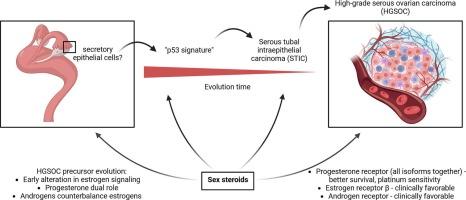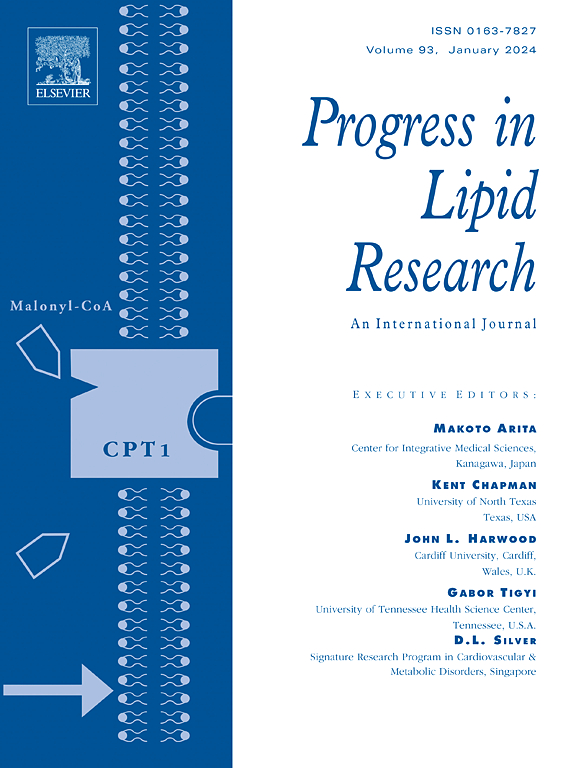From fallopian tube epithelium to high-grade serous ovarian cancer: A single-cell resolution review of sex steroid hormone signaling
IF 14
1区 医学
Q1 BIOCHEMISTRY & MOLECULAR BIOLOGY
引用次数: 0
Abstract
High-grade serous ovarian cancer (HGSOC) represents the most lethal subtype of ovarian cancer, largely due to being commonly diagnosed at advanced stages. The early molecular mechanisms underlying ovarian carcinogenesis remain poorly defined, posing challenges to the development of prevention and early detection strategies. Here we dissect the molecular mechanisms of sex steroid hormone signaling throughout the decades-long evolution of HGSOC precursor lesions, which predominantly originate from secretory epithelial cells of fallopian tubes (FT). We also discuss the prognostic significance of sex steroid receptor isoforms and steroid metabolizing enzymes in HGSOCs. Finally, we provide a comprehensive gene expression atlases of sex steroid receptors, steroidogenic, and steroid-metabolizing enzymes across different cell populations in pre- and postmenopausal FTs, and HGSOCs, using published single-cell RNA sequencing datasets. These atlases reveal that secretory epithelial cells and stromal populations in FTs express sex steroid receptors and enzymes responsible for the formation and inactivation of genotoxic estrogen metabolites. In HGSOC, epithelial cells express various HSD17B isoforms and steroid conjugating enzymes, suggesting an enhanced ability to finely regulate the levels of bioactive sex steroids.

从输卵管上皮到高级别浆液性卵巢癌:性类固醇激素信号传导的单细胞分辨率回顾
高分化浆液性卵巢癌(HGSOC)是卵巢癌中致死率最高的亚型,这主要是因为它通常在晚期才被诊断出来。卵巢癌发生的早期分子机制尚未明确,这给预防和早期检测策略的制定带来了挑战。在此,我们剖析了在长达数十年的 HGSOC 前体病变演变过程中性激素信号传导的分子机制,这些前体病变主要起源于输卵管(FT)的分泌性上皮细胞。我们还讨论了性类固醇受体同工酶和类固醇代谢酶在 HGSOC 中的预后意义。最后,我们利用已发表的单细胞 RNA 测序数据集,提供了绝经前后 FT 和 HGSOCs 不同细胞群中性激素受体、类固醇生成酶和类固醇代谢酶的综合基因表达图谱。这些图谱显示,FTs 中的分泌性上皮细胞和基质细胞群表达性类固醇受体和酶,这些受体和酶负责形成和灭活基因毒性雌激素代谢产物。在 HGSOC 中,上皮细胞表达各种 HSD17B 同工型和类固醇结合酶,这表明其精细调节生物活性性类固醇水平的能力有所增强。
本文章由计算机程序翻译,如有差异,请以英文原文为准。
求助全文
约1分钟内获得全文
求助全文
来源期刊

Progress in lipid research
生物-生化与分子生物学
CiteScore
24.50
自引率
2.20%
发文量
37
审稿时长
14.6 weeks
期刊介绍:
The significance of lipids as a fundamental category of biological compounds has been widely acknowledged. The utilization of our understanding in the fields of biochemistry, chemistry, and physiology of lipids has continued to grow in biotechnology, the fats and oils industry, and medicine. Moreover, new aspects such as lipid biophysics, particularly related to membranes and lipoproteins, as well as basic research and applications of liposomes, have emerged. To keep up with these advancements, there is a need for a journal that can evaluate recent progress in specific areas and provide a historical perspective on current research. Progress in Lipid Research serves this purpose.
 求助内容:
求助内容: 应助结果提醒方式:
应助结果提醒方式:


